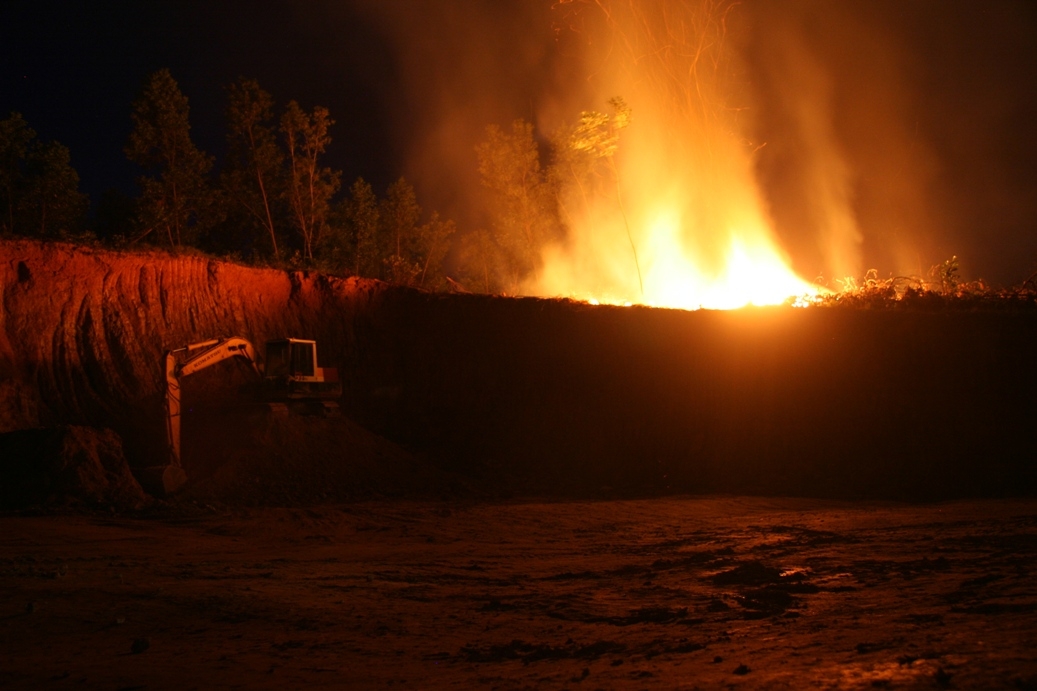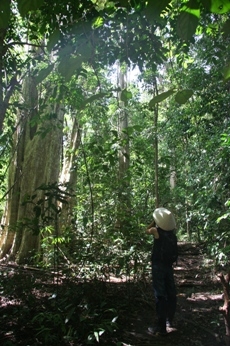They live on the outskirts of the Cat Tien National Park and have for years had to go into the park in search of farm land, firewood, and wild animals to sustain a living. Now former poachers find alternative sources of income in an eco-tourism project supported by WWF to improve livelihood and preserve the park.
He knows the park in and out; knows where to search for succulent bamboo shoots and uses his hatchet skilfully to chop off small pieces of bark for us to chew against stomach cramps.
K’ So is just one of many poor farmers living on the outskirts of the Cat Tien National Park who for years have been forced by poverty to venture into the park illegally in search of food and firewood. But not so anymore. The 50 year old Ma-ethnic minority man has recently been appointed an eco-tourist guide in a project supported by the Danish Government (Danida) and WWF-Denmark.

Slash and burn farming practices are still widespread in and around the national park.
Described as a unique forest, Cat Tien National Park 100 km North-east of Ho Chi Minh City provides not only fertile soil for some 1,600 different plants and home to 348 species of birds, but also habitat to the last remaining wild rhinoceroses on the Asian mainland. With a population of only 3-5 animals, the Javan Rhino is already on the brink of extinction – poached for their horns thought to offer potential medical benefits and pushed out of their natural habitat by slash and burn farming practiced for generations in and along Cat Tien.
“The rhinos have been surrounded by villages and farmed land and have had no where to go”, says Tran Minh Hien, director of WWF-Vietnam.
Because of its unique wildlife, forests and mountains Cat Tien National Park has been targeted by WWF as an area for preservation and eco-tourism development.
Working closely with the local authorities, the wildlife group launched a project in July this year to benefit the livelihood of poor farmers in the two communes of Tien Hoang and Phuoc Cat 2 in Lam Dong Province.
With a proportion of poor households as high as 56 percent and a per capita income of just 300 US$, the two communes are among the poorest. Bordering one of Vietnam’s most lush natural forests, the park’s vast natural resources has for years been too much of a temptation for many.
“These people are desperately poor, but they live in the buffer zone of one of the richest biodiversity hotspots in Vietnam, so no one can blame them for venturing into the park to seize farmland or to search for food”, says Lasse Juul-Olsen, programme officer with WWF-Denmark.
Consequently the prime goal of the eco-tourism project is to improve livelihoods among poor people, and subsequently ease the pressure on the unique forest system of the 72,000 hectare Cat Tien National Park.
“The two are interlinked”, explains Lasse Juul-Olsen and points to the fact that eco-tourism offers a long-term solution to the short-term illegal activities locals have had to carry out to earn a living: “Locals must be given the offer of an alternative livelihood to understand that it is in their own interest to reduce the pressure on the natural resources and preserve the forest for future generations.”
In other words: When families no longer go hungry, hopefully they will see that a richer wildlife and a more pristine forest will attract tourists – and in turn generate income for local communities. “Community based tourism is a huge challenge. Experience shows that it is really difficult go get it up and running”, says Lasse Juul-Olsen. “
We hope this will generate income in the local communities, but this is not Nirvana coming down to local people. This is why we tell them: “Don’t stop farming in the hope that tourism will bring in a change of life tomorrow”. It is an additional source of income coming in, not a complete alternative to the present way of life”.

Our poacher turned eco-guide K' So, who only went to the park to fetch bamboo shoots.
Many families have already gained from changing their way of life according to the project, which has benefitted poor locals like K’ So. His skills and knowledge of the huge national park are now also put to better use looking after 12 ha of the park for the government, protecting the wildlife, preserving the land and keeping an eye out for poachers. For this he is paid 1.2 million VND each year. But there are many other ideas on the table: “
We don’t just want local ethnic minority groups to dance in front of tourists; we want to create other links between locals and tourists. We want to source fruits and vegetables locally, buy their handicraft and arrange home stays as a way of generating income locally – in order to preserve the traditions of the ethnic minority groups and in order to save the forest”, says Tran Minh Hien: “Local villagers expect a lot from this project”.

A tourist enjoying the silence and splendour of the pristine forest.
Just how much can be given back to the local community we discover, when we arrive at Forest Floor Lodge to spend the night. Situated by the Dong Nai River and overlooking part of the national park, the eco-lodge restaurant serves food prepared from locally sourced ingredients, while staffs come in from surrounding villages. The main building formerly served as part of the park rangers’ headquarters and was of no architectural value. But adhering to eco friendly practices it was extended using local workers and locally sourced building materials instead of taken down.
The fact that this building has now been taken over by eco-tourists is almost symbolic, since a few years back the building served as the park rangers’ prison for poachers caught inside the park.
| Merete Jensen is a Danish journalist working in Hanoi as the regional correspondent of Danish daily newspaper Kristeligt Dagblad. She holds a master's degree in Sociology from Londons City University. She has previously lived and worked in Washington D.C., Moscow, Copenhagen and London. |
